Best join.com Alternatives in 2026: 10 Tools for Faster, More Effective Hiring

Tired of dealing with poor customer service, limited free job postings, and integration challenges on join.com? There's a better way to streamline your recruitment process. Explore these top join.com alternatives that offer enhanced transparency, improved candidate management, efficient sorting and filtering of candidates, and more affordable pricing options.
join.com Alternatives
the best candidates faster
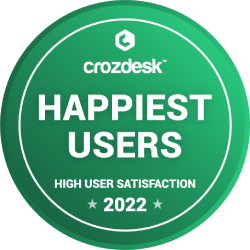
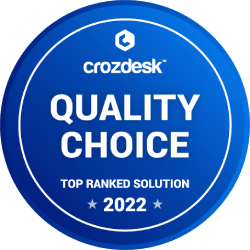
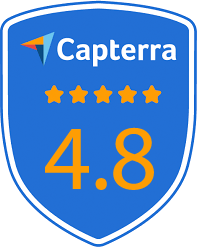
100Hires
100Hires is a very popular ATS among small and mid-sized companies, it holds numerous G2 badges, including 'Leader' in Recruitment Marketing and Candidate Relationship Management, 'Most Implementable' for Small-Business and Mid-Market, and 'Best Usability' across multiple categories. Ready to experience 100Hires? Get a demo or start your free trial today to see how 100Hires can optimize your hiring process. For more information on plans and options, check out our pricing page.
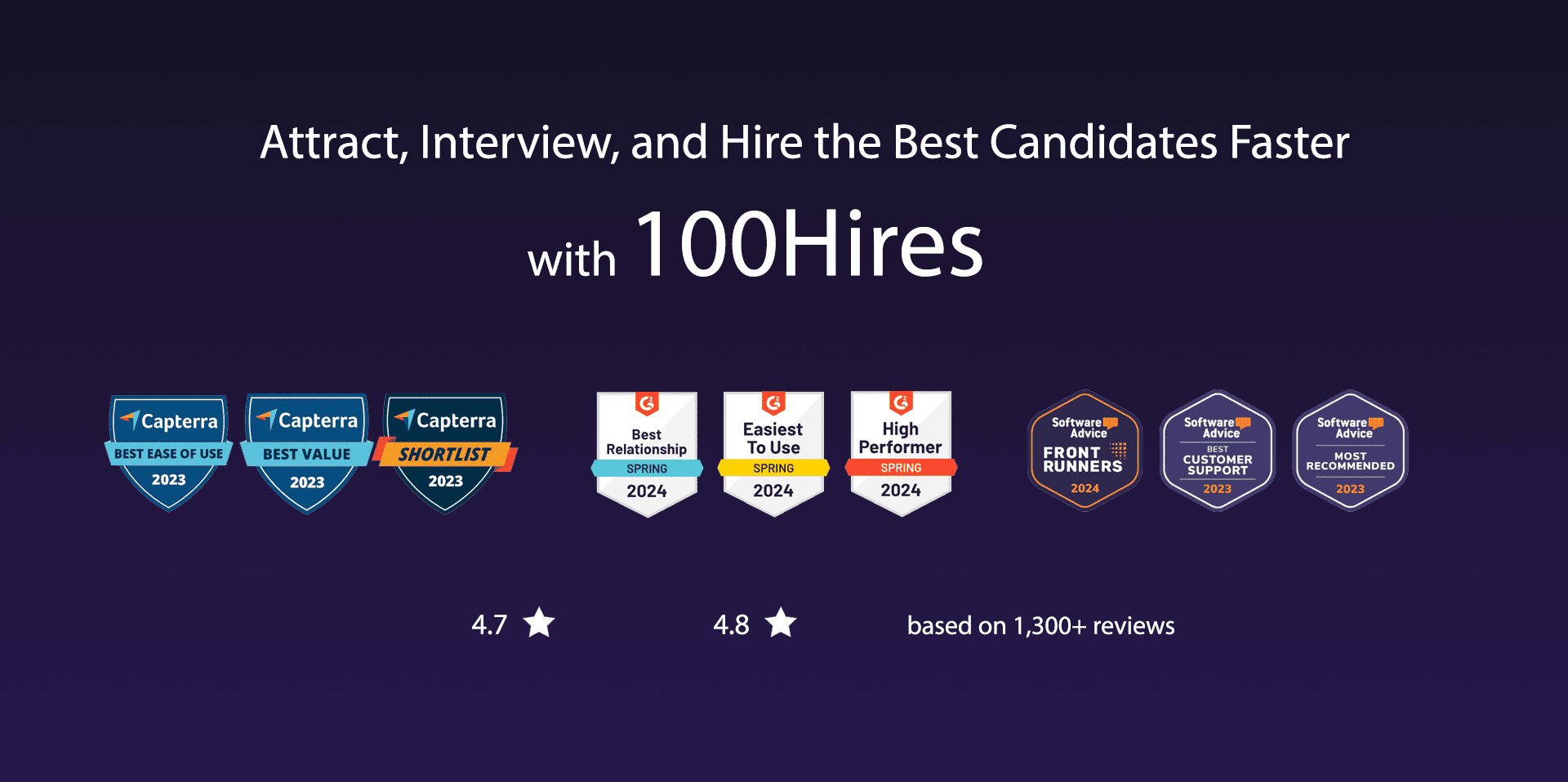
G2 rating: 4.8/5 based on 831 reviews.
Capterra rating: 4.9/5 based on 742 reviews.
1. Increased Applicant Reach:
- Post to major job boards (Indeed, LinkedIn, Glassdoor, etc.) with a single click, expanding job visibility and attracting more top talent.
- Real-time tracking and analytics allow clients to monitor job posting performance and optimize recruitment strategies.
2. Streamlined Recruitment Process:
- Centralized candidate data with easy access to interaction history and candidate statuses.
- Reduces duplicate communication and enhances the candidate experience.
3. Time Savings with AI:
- AI-generated job descriptions, application forms, and interview questions reduce time spent on resume screening.
- AI-driven candidate ranking helps prioritize the best candidates quickly.
4. Automation for Efficiency:
- Integrated scheduling with Google or Outlook calendars, knockout questions, duplicate detection, and automated communications (notifications, follow-ups) reduce manual effort.
- Zapier integration allows seamless connectivity with third-party tools.
100Hires Pricing:
100Hires offers three pricing tiers: Start at $75/month (billed annually) for companies with minimal hiring needs, supporting up to 3 jobs and 1 user. The Advanced plan, at $199/month, includes unlimited jobs, candidates, and users, plus features like automated emails and a custom domain. The Pro plan, at $399/month, adds advanced sourcing tools, contact enrichment, and onboarding support, ideal for sourcing passive candidates.
Lever
Lever, founded in 2012, is an applicant tracking system that raised $122.8 million, including $50 million in 2021, and was acquired by Employ less than a year later. In April 2020, Lever cut about 40% of its workforce amid an economic downturn.
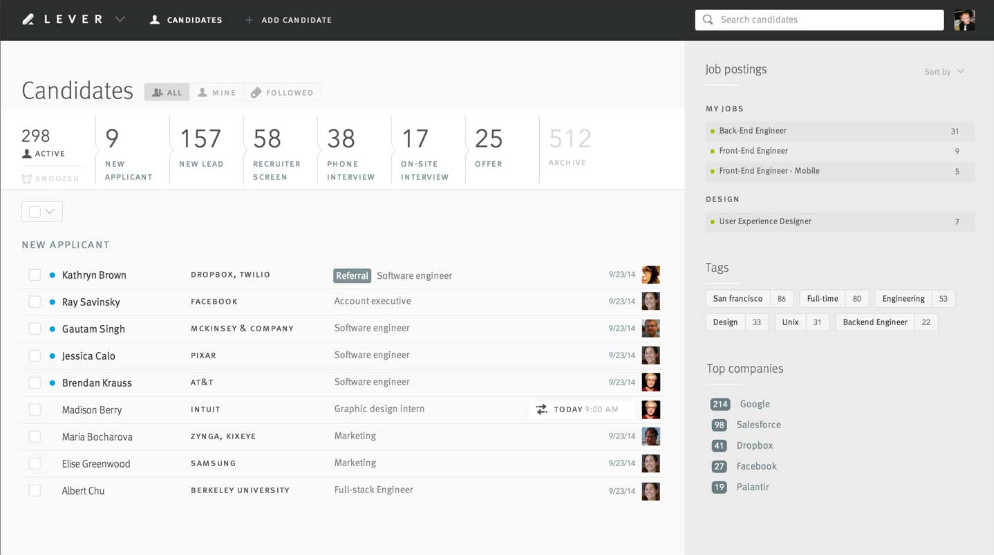
G2 rating: 4.3/5 based on 2007 reviews.
Capterra rating: 4.6/5 based on 639 reviews.
Lever's typical customers are primarily based in the United States (52.85%), with smaller shares in India (11.61%), Canada (6.74%), the United Kingdom (4.76%), and Brazil (1.38%). Key industries include Computer Software (27%), Information Technology and Services (6%), Financial Services (4%), Internet (3%), and Education Management (3%).
According to G2, 82% of customers have 51-1000 employees, 4% have fewer than 50 employees, and 14% have more than 1000. Capterra reviews show 29.6% of customers with 51-200 employees, and smaller shares across other size categories.
Lever Pricing:
Lever’s pricing varies widely based on company needs, with costs influenced by selected plans, add-ons, and number of seats. While annual prices range from a median of $3,800 to a maximum of $350,000, the average cost is around $24,000. Some organizations report quotes between $500 and $800 per month, with implementation fees around $5,000. Pricing is customized, often negotiated, and specific to each organization.
Lever Pros:
- Ease of Use and Intuitive Interface (mentioned 41 times): Users appreciate Lever's user-friendly design, making it easy to navigate and adopt across different levels of the organization, including recruiters, hiring managers, and employees.
- Efficient Candidate Management (mentioned 22 times): Lever's features for managing candidates throughout the recruitment process, including scheduling, feedback collection, and communication, are highlighted as key strengths.
- Comprehensive Integration Capabilities (mentioned 18 times): Lever's ability to integrate seamlessly with a wide range of other platforms and tools, including Google services, LinkedIn, and various HR systems, is frequently praised.
Lever Cons:
- Limited Reporting and Analytics Without Premium (mentioned 4 times): Users find the basic analytics and reporting features limited, requiring a premium subscription for more comprehensive options.
- Lack of Certain Functionalities (mentioned 3 times): Users wish for more functionalities like bulk resume download, more robust duplicate profile management, and better customization for offer letters.
- Lack of Certain Features (mentioned 2 times): Users note the absence of some features available in other ATS systems, expressing hope for future releases.
- User Access Customization Limitations (mentioned 2 times): There's a desire for more granular control over user access and permissions, allowing for more specific access profiles for different teams.
- Integration Limitations (mentioned 2 times): Some users experience challenges with integrations, particularly with e-signature services and desire more integration options.
- Challenges with Interview Scheduling (mentioned 2 times): Users find the interview scheduling tool could be more straightforward and flexible.
- Customer Support Accessibility (mentioned 2 times): Some users report difficulties in getting timely support, especially with integration issues.
- Navigational Complexity (mentioned 1 time): A few users find navigating through the menus not as easy or intuitive as it could be.
- No Mobile App (mentioned 1 time): The absence of a mobile application makes it challenging for hiring managers to conduct quick screenings on the go.
- Cost Concerns (mentioned 1 time): The user seat model is seen as expensive, especially for larger organizations or those where only a small percentage of employees use the system regularly.
myStaffingPro
myStaffingPro, founded in 1993, is an applicant tracking system based in India that was acquired by Paychex.
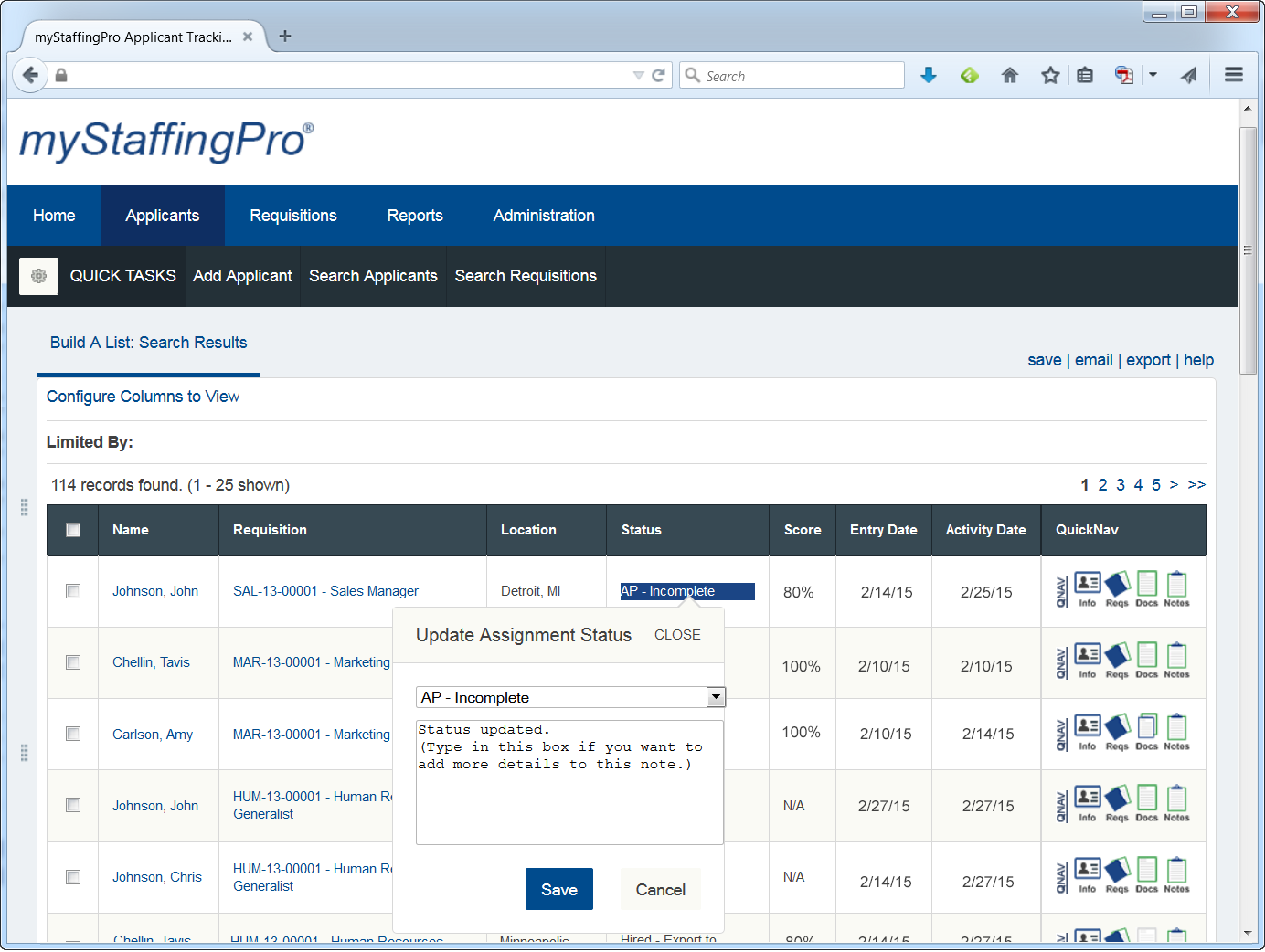
G2 rating: 3.9/5 based on 15 reviews.
Capterra rating: 3.9/5 based on 68 reviews.
myStaffingPro's typical customers are entirely based in the United States. Key industries include Medical Practice (18%), Transportation/Trucking/Railroad (12%), Banking (12%), Human Resources (6%), and Hospital & Health Care (6%).
According to G2, 46.7% of customers have 51-1000 employees, 33.3% have fewer than 50 employees, and 20% have more than 1000.
myStaffingPro Pricing:
myStaffingPro offers flexible, per-user monthly pricing, starting at $50 per user for small businesses and decreasing to about $20 per user for large enterprises with over 1,000 users. For a company with 10 users, costs average $30 per user per month, while 100-user organizations pay around $25 per user. Implementation fees vary by business size, with small businesses paying $1,000 to $5,000, medium-sized businesses $5,000 to $15,000, and large enterprises over $15,000, with timelines ranging from 1 to 6 weeks depending on the organization’s complexity.
myStaffingPro Pros:
- Ease of Use and Straightforward Implementation (mentioned 11 times): myStaffingPro is lauded for its user-friendly interface and simple setup process, making it accessible for both administrators and users, and reducing the learning curve associated with new software adoption.
- Responsive and Helpful Customer Service (mentioned 5 times): The platform's customer service is highly regarded, with users appreciating the quick, effective responses and the supportive assistance provided for resolving issues and optimizing the use of the system.
- Smooth Onboarding Process (mentioned 4 times): The onboarding functionality of myStaffingPro is praised for its efficiency and ease, facilitating a seamless transition for new hires and significantly reducing the administrative burden associated with paperwork.
myStaffingPro Cons:
- Integration and Compatibility Issues (mentioned 7 times): Users report challenges with integration, particularly between myStaffingPro and Paychex Flex, and issues with compatibility with mobile devices and Microsoft Outlook, leading to inefficiencies and limitations in use.
- Customer Service and Support Concerns (mentioned 5 times): There are complaints about the quality of customer service, including slow response times, frequent changes in contact personnel without notice, and a lack of effective communication and support.
- System Customization and Flexibility Limitations (mentioned 4 times): Users find the system less customizable and flexible than expected, with specific difficulties in tailoring offer letters without HTML knowledge and limitations in mobile accessibility for certain application processes.
- User Interface and Usability Challenges (mentioned 4 times): Some users find the system difficult to navigate, particularly in finding tasks and managing candidate information, and mention a steep learning curve for those not familiar with HR work.
- Additional Fees and Implementation Time for Changes (mentioned 2 times): There are frustrations with the need for additional fees and extended implementation times for making changes or updates to the system, which is problematic for evolving companies.
- Manual Processes and Data Entry (mentioned 2 times): Despite the automation features, users note the burden of manual data entry, especially when adding new requisitions or overriding the system for specific data inputs.
- Reporting and Analytics Limitations (mentioned 2 times): Users express a desire for improved reporting functionality and dashboard information, indicating that the current capabilities do not meet their needs for specific data analysis and reporting.
- Cost Concerns (mentioned 2 times): While some users acknowledge the features justify the cost, others suggest the platform is more expensive compared to other options, with one mentioning the need to invest more for quality if using the ATS heavily.
- Operational Glitches and Slow Performance (mentioned 2 times): Complaints include slow page loading, system glitches, and errors, which hinder the efficiency of recruitment processes and user experience.
- Lack of Advanced Notification for System Changes (mentioned 1 time): Users would appreciate more lead time and better communication regarding system updates or changes to prepare and adjust workflows accordingly.
Paradox
Paradox, founded in 2016, is an applicant tracking system based in Vietnam that raised $253.3 million and acquired Traitify and Spetz.
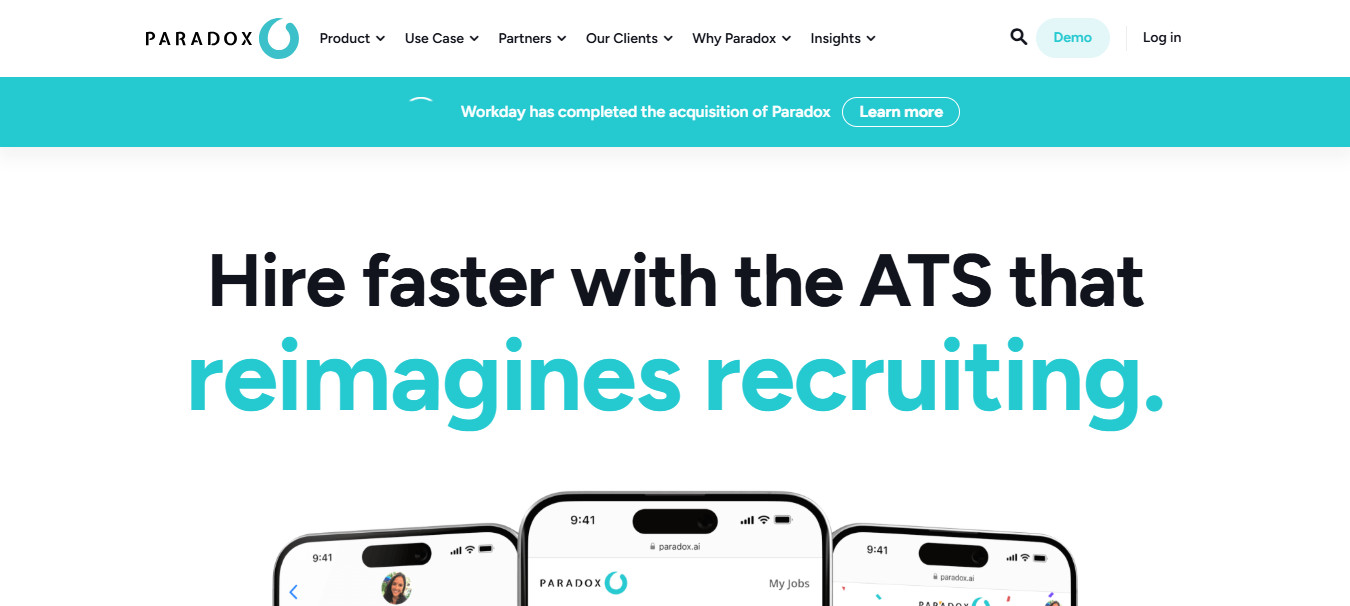
G2 rating: 4.7/5 based on 39 reviews.
Capterra rating: 4.7/5 based on 3 reviews.
Paradox's typical customers are primarily based in the United States (92.57%), with smaller shares in Canada (1.73%), the United Kingdom (1.31%), India (0.87%), and Australia (0.4%). Key industries include Hospital & Health Care (50%) and Transportation/Trucking/Railroad (50%).
According to G2, 53.8% of customers have more than 1000 employees, 28.2% have 51-1000 employees, and 17.9% have fewer than 50 employees. Capterra reviews show an even split, with 50% of customers having 501-1,000 employees and 50% having more than 10,000 employees.
Paradox Pricing:
Paradox’s Olivia pricing begins at $1,000 per month, with costs scaling up for larger organizations. Pricing depends on the specific features, support, training, and customization required, making it adaptable to different company sizes and needs. Some users report monthly costs around $1,500, reflecting Paradox's scalable pricing model.
Paradox Pros:
- Exceptional Customer Service and Support (mentioned 12 times): Users consistently praise the high level of customer service provided by the Paradox team, highlighting the responsiveness, helpfulness, and efficiency of support staff and customer success managers.
- Time-Saving Automation (mentioned 11 times): The automation features, particularly through the virtual assistant Olivia, are highly valued for saving significant amounts of time in contacting applicants, filtering candidates, and reducing back-and-forth communication.
- Innovative and User-Friendly Technology (mentioned 10 times): Paradox is recognized for its innovative solutions and user-friendly interface, making it easy for both candidates and recruiters to navigate and use the platform effectively.
Paradox Cons:
- Implementation and Integration Challenges (mentioned 8 times): Users have experienced difficulties with the implementation process and integrating Paradox with existing systems, including ATS and Outlook calendars. Some mention that integration can be rocky or that the process takes longer than expected.
- Complexity and User-Friendliness (mentioned 7 times): While Paradox is praised for its robust features, some users find the platform could be more user-friendly and that there's a learning curve to fully utilize its capabilities. The UI is specifically mentioned as not being intuitive for some users.
- Reporting and Analytics (mentioned 6 times): The complexity and readability of reports have been pointed out as areas for improvement. Users desire more straightforward, customizable, or canned reports to easily extract meaningful insights without extensive manual effort.
- Dependence on Technology and Loss of Personal Touch (mentioned 5 times): Some recruiters express concern that reliance on Paradox's technology could lead to a loss of personal touch in the recruitment process, emphasizing the importance of balancing tech with human interaction.
- Response Accuracy and AI Limitations (mentioned 4 times): The AI, while innovative, doesn't always respond appropriately to all applicant questions, leading to some frustration. Users would like to see improvements in AI's understanding and response capabilities.
- Customization and Feature Requests (mentioned 3 times): Users express a desire for more customization options, particularly in labeling candidates in the CRM and enhancing virtual event components. There's also a wish for more robust analytics and training on certain features.
- Service and Support Delays (mentioned 2 times): Although customer service is generally praised, there are mentions of delays in receiving support for more complicated tasks or custom projects, with some projects extending past initial timelines.
- Color Coordination and Interface Usability (mentioned 1 time): One specific feedback mentioned the lack of color coordination to easily identify interviews by location, and the inconvenience of opening new web tabs for each applicant interaction.
- No-call, No-show Rates and Redundant Functions (mentioned 1 time): Users noted issues with no-call, no-show rates for interviews scheduled through Paradox and mentioned some functions or stages as redundant.
- Optimism on Timelines for New Features (mentioned 1 time): There's a perception that Paradox can sometimes be overly optimistic about how quickly new features can be added or projects completed.
Phenom
Phenom, founded in 2010, is an applicant tracking system based in India that raised $161.4 million and acquired Tydy, Tandemploy, Talentcube, Endouble, and My Ally.
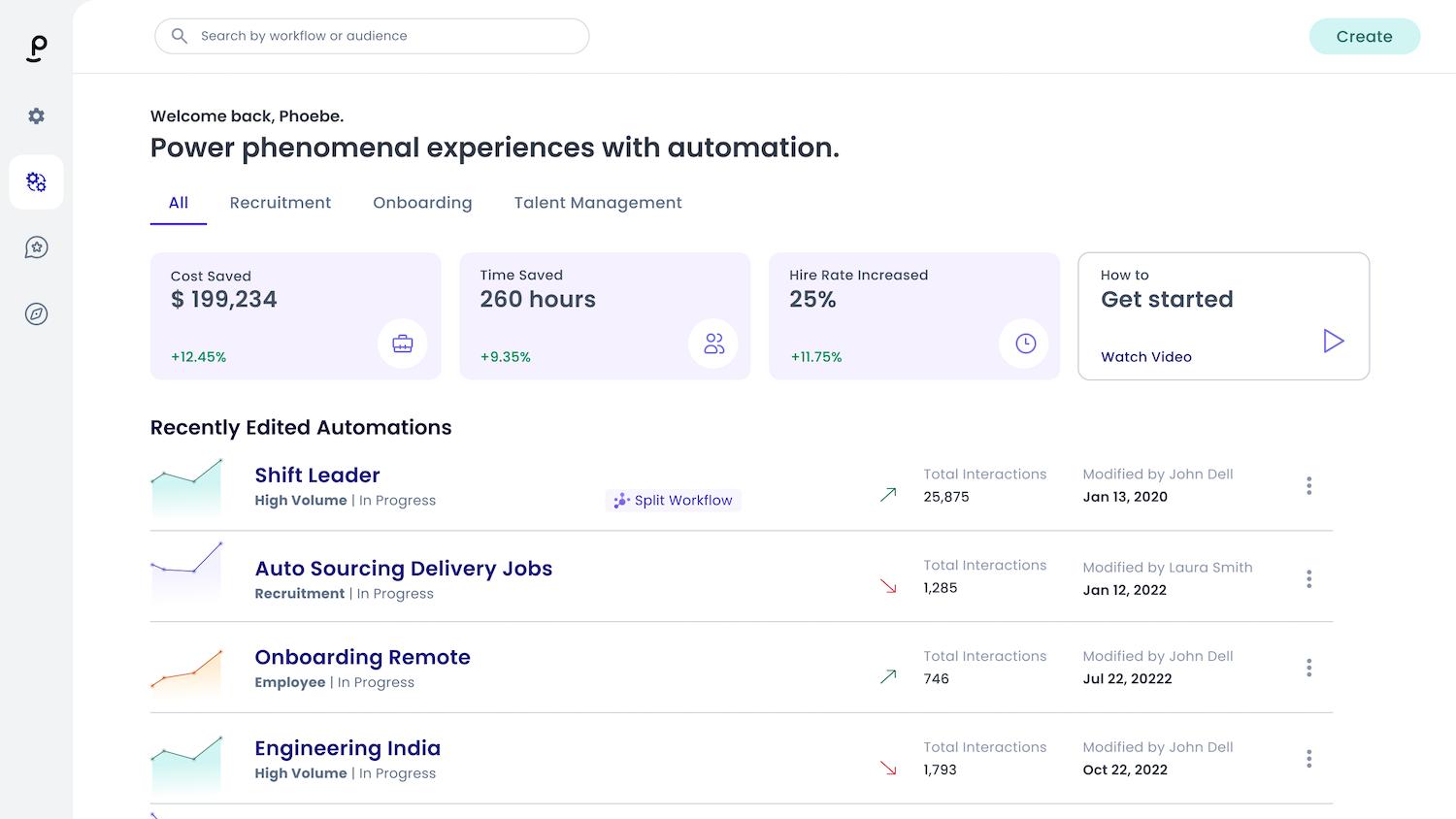
G2 rating: 4.4/5 based on 373 reviews.
Capterra rating: 3.9/5 based on 13 reviews.
Phenom's typical customers are primarily based in the United States (36.22%), with smaller shares in India (11.14%), the United Kingdom (7.41%), Australia (6.24%), and Germany (5.69%). Key industries include Insurance (27%), Biotechnology (18%), Financial Services (9%), Telecommunications (9%), and Transportation/Trucking/Railroad (9%).
According to G2, 84% of customers have more than 1000 employees, 8% have 51-1000 employees, and 8% have fewer than 50 employees. Capterra reviews show 41.7% of customers with more than 10,000 employees, and smaller shares across other size categories.
Phenom Pricing:
Phenom's pricing starts at approximately $10,000 per month, with a per-user model that scales with the number of users, making it suitable for various organization sizes. Pricing varies based on specific needs, including selected modules, integration requirements, and the level of support and customization required. Custom quotes are available to match the unique requirements of each organization. For a precise estimate, contacting Phenom directly for a tailored quote is recommended.
Phenom Pros:
- Ease of Use and User-Friendly Interface (mentioned 15 times): Users appreciate Phenom's intuitive platform, highlighting its user-friendly nature that simplifies the recruitment process and makes it easy for new users to learn and navigate.
- Efficient Candidate Management and Organization (mentioned 12 times): The ability to sort candidates into different lists and projects, manage pipelines, and track candidates efficiently helps recruiters stay organized and know exactly where each candidate stands in the hiring process.
- Automation and Time-Saving Features (mentioned 10 times): Features like bulk emails, SMS messaging, automated scheduling, and the use of AI for candidate screening are valued for saving time and automating repetitive tasks, allowing recruiters to focus on more strategic activities.
Phenom Cons:
- Integration and Implementation Challenges (mentioned 12 times): Users have experienced difficulties with integrating Phenom into existing ATS systems like Cornerstone and Workday, noting that the implementation process can be lengthy, complex, and sometimes not fit for purpose initially.
- Customer Support and Response Times (mentioned 8 times): While support is often effective, users have noted delays in response times and resolution of issues, expressing a desire for faster turnaround and more proactive support.
- Complexity and Usability Issues (mentioned 7 times): Some users find Phenom's platform complex and not as intuitive as they would like, particularly in navigating between different functions such as projects, lists, and spotlights.
- Limited Email Integration and Manual Data Entry (mentioned 5 times): Users wish for better integration with email platforms like Outlook to automatically sync email exchanges with candidates into the CRM, reducing the need for manual data entry.
- Customization and Functionality Limitations (mentioned 4 times): There are calls for more customization options, particularly in campaign touchpoints and the ability to create personal email and video interview templates without affecting other users.
- Bugs and System Performance Issues (mentioned 3 times): Some users report encountering bugs and performance issues, such as slow loading times and system glitches, that can hinder the user experience.
- Learning Curve and Training (mentioned 2 times): The platform's wide range of functionalities can lead to a steep learning curve, with some users feeling that training modules do not always adequately prepare them for using the system effectively.
- Lack of Advanced Reporting and Analytics (mentioned 1 time): Users desire more robust and customizable reporting and analytics capabilities to gain deeper insights into recruitment processes.
- Insufficient Texting Capabilities (mentioned 1 time): The lack of texting capabilities from the platform is noted as a drawback, as many candidates prefer mobile communication.
- Content Management System (CMS) Limitations (mentioned 1 time): Some users find the CMS for website content to be limited in terms of customization, making it challenging to create unique and engaging career sites.
Pinpoint
Pinpoint, founded in 2018, is an applicant tracking system based in the United Kingdom.
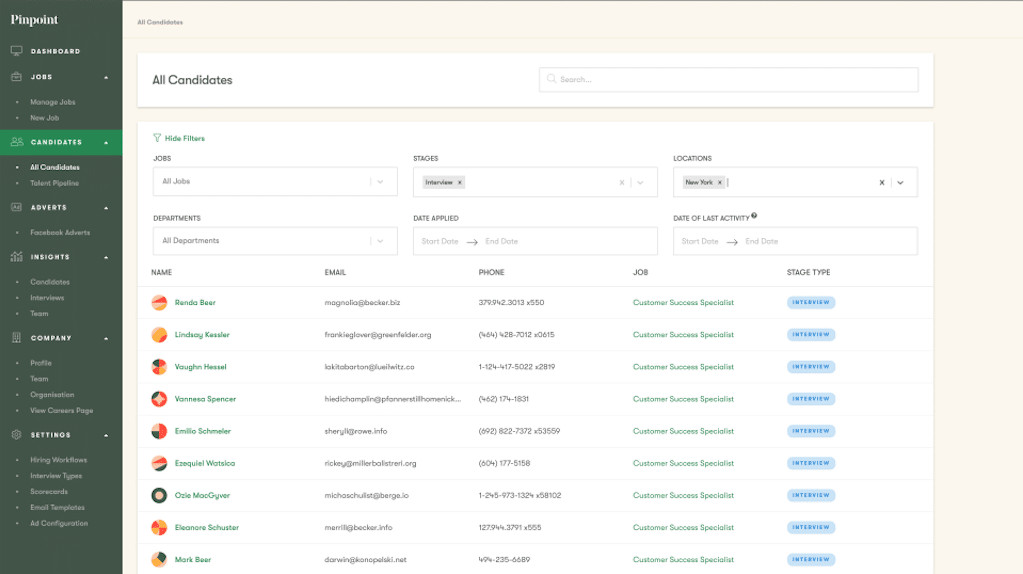
G2 rating: 4.6/5 based on 79 reviews.
Capterra rating: 4.5/5 based on 55 reviews.
Pinpoint's typical customers are primarily based in the United States (29.16%) and the United Kingdom (24.65%), with smaller shares in India (4.63%), the Philippines (4.46%), and Kenya (3.46%). Key industries include Financial Services (20%), Utilities (11%), Telecommunications (10%), Information Technology and Services (8%), and Investment Management (5%).
According to G2, 60% of customers have 51-1000 employees, 22.2% have fewer than 50 employees, and 17.8% have more than 1000. Capterra reviews show 32.3% of customers with 51-200 employees, and smaller shares across other size categories.
Pinpoint Pricing:
Pinpoint offers premium, quote-based pricing plans without a free trial. Pricing is customized based on specific business needs and features required.
Pinpoint Pros:
- User-Friendly Interface and Ease of Use (mentioned 18 times): Users appreciate Pinpoint's intuitive design and easy navigation, which simplifies the recruitment process and makes it accessible for users of all skill levels.
- Efficient Candidate Management (mentioned 12 times): The platform's ability to organize candidates, manage applications, and streamline the hiring workflow is highly valued, making it easier for recruiters to track the progress of each candidate.
- Effective Communication with Candidates (mentioned 10 times): Features like bulk messaging, email campaigns, and integrated communication tools are praised for facilitating efficient outreach to candidates and improving engagement throughout the recruitment process.
Pinpoint Cons:
- Feature Availability and Development (mentioned 2 times): Users appreciate the continuous development of new features but note that some desired functionalities are still in development or unavailable.
- Scheduling Limitations (mentioned 2 times): There are challenges with scheduling multiple candidates with different hiring managers for the same role simultaneously, and improvements are desired in the scheduling feature for better detail visibility in calendar invites.
- Navigation and Usability Concerns (mentioned 2 times): Users wish for fewer clicks to move candidates around and for a more intuitive way to switch between pages or candidates without experiencing delays.
- Integration with Other Platforms (mentioned 1 time): The lack of integration with platforms like ATS, which can cause duplication of workflows, and a desire for better integration with email platforms like Outlook for syncing communications.
- Data Management (mentioned 1 time): Concerns about not being able to retrieve deleted information and the need for better management of important fields when inputting candidates.
- Email Deliverability (mentioned 1 time): Some in-platform emailing gets sent to candidates' promotions folders, which could affect the visibility of communications.
- Customization and Reporting (mentioned 1 time): A desire for customizable dashboards and more detailed reporting capabilities to better match managerial interests.
- User Guide and Training (mentioned 1 time): A suggestion for a user guide for line managers to aid in training and better utilization of the system.
- Design and Aesthetic Limitations (mentioned 1 time): While the user interface is generally liked, there's a desire for more customization options to enhance the look and feel of the recruitment website generated by Pinpoint.
- Bias and Diversity Features (mentioned 1 time): The anti-bias feature was confusing for new users, suggesting a need for better initial guidance on system functionality.
Recruitee
Recruitee, founded in 2015, is an applicant tracking system based in Poland and the Netherlands that acquired Sympa.
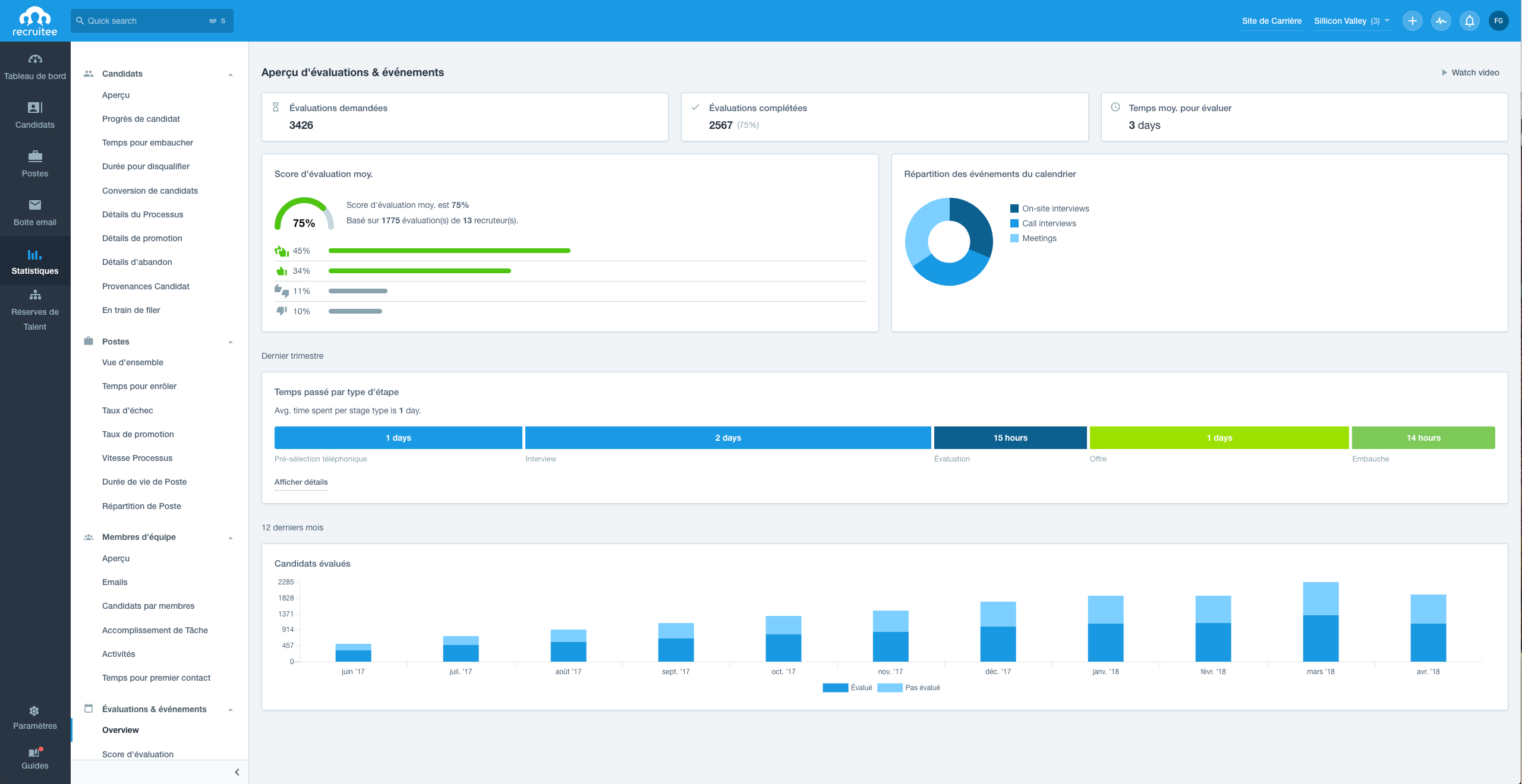
G2 rating: 4.5/5 based on 430 reviews.
Capterra rating: 4.4/5 based on 184 reviews.
Recruitee's typical customers are primarily based in the Netherlands (14.1%), the United States (13.58%), Germany (9.4%), India (7.11%), and the United Kingdom (6.27%). Key industries include Information Technology and Services (16%), Computer Software (13%), Internet (7%), Human Resources (7%), and Staffing and Recruiting (5%).
According to G2, 54% of customers have 51-1000 employees, 36% have fewer than 50 employees, and 10% have more than 1000. Capterra reviews show 31.2% of customers with 11-50 employees and 26.4% with 51-200 employees, with smaller shares across other size categories.
Recruitee Pricing:
Recruitee offers three main plans, adjusted for company size:
Start ($249/month, annual contract): Ideal for businesses starting their hiring journey, includes 5 job slots, unlimited users, multi-job posting, single-page careers site, CV parsing, email/calendar sync, pipeline automations, talent pools, standard reporting, and optional add-ons like SSO and texting.
Grow ($311–$936/month, depending on company size): Designed for fast-growing teams with unlimited job slots and users, it includes all Start features, plus multi-page/multi-language careers sites, referral programs, event scheduling, candidate screening with questionnaires and knockout questions, multi-location support, custom reporting, and an optional onboarding add-on.
Optimize (Custom pricing, contact sales for details): Tailored for recruitment agencies and large enterprises, offering unlimited job slots and users, all Grow features, along with onboarding support, a dedicated customer success manager, requisition approvals, fair evaluations, BI tool integration, SSO, API support, and optional texting.
Recruitee Pros:
- User-Friendly and Intuitive Interface (mentioned 23 times): Users appreciate Recruitee's ease of use, intuitive design, and simple navigation, making it accessible for both HR professionals and hiring managers.
- Comprehensive Features and Functionality (mentioned 18 times): The platform offers a wide range of features, including one-way video interviews, email templates, automation, and a customizable ATS pipeline, which streamline the recruitment process.
- Effective Collaboration Tools (mentioned 12 times): Recruitee facilitates collaboration among team members, allowing for easy sharing of candidate information, feedback, and interview notes within the platform.
Recruitee Cons:
- Limited Customization and Integration Capabilities (mentioned 12 times): Users desire more flexibility in customizing the career pages, job descriptions, and integrating with other systems like CRMs and VOIP services.
- Feature Limitations and Requests for Enhancements (mentioned 11 times): There's a call for more advanced features, such as better reporting tools, more automation options, VOIP integration, and improvements to the talent pool functionality.
- User Interface and Experience Issues (mentioned 8 times): Some users find certain aspects of the UI cluttered or challenging to navigate, particularly when editing job descriptions or managing candidate profiles.
- Pricing and Subscription Model Concerns (mentioned 7 times): Concerns were raised about the pricing model, particularly regarding the cost-effectiveness and flexibility of the subscription plans.
- Technical Glitches and Bugs (mentioned 6 times): Users have encountered technical issues, such as bugs with email editing, event scheduler disconnections, and occasional platform lag.
- Limited Global View and Analytics (mentioned 5 times): There's a desire for a more comprehensive global pipeline view and more in-depth analytics and reporting features.
- Customer Support and Service Issues (mentioned 4 times): While many users praise the support, some have experienced delays or dissatisfaction with the customer service response.
- Data Management and Export Limitations (mentioned 3 times): Users would like more robust options for data management, including easier ways to export and manipulate data outside of Recruitee.
- Job Posting and Advertisement Management (mentioned 2 times): Some users find the job posting process, particularly the management of live and edited jobs, to be cumbersome or limiting.
- Learning Curve and Onboarding (mentioned 1 time): A few users mentioned a steep learning curve or the need for more guidance during the initial setup and onboarding process.
SmartRecruiters
SmartRecruiters, founded in 2010, is an applicant tracking system based in Poland that raised $225 million and acquired Attrax, jobpal, and Jobspotting.
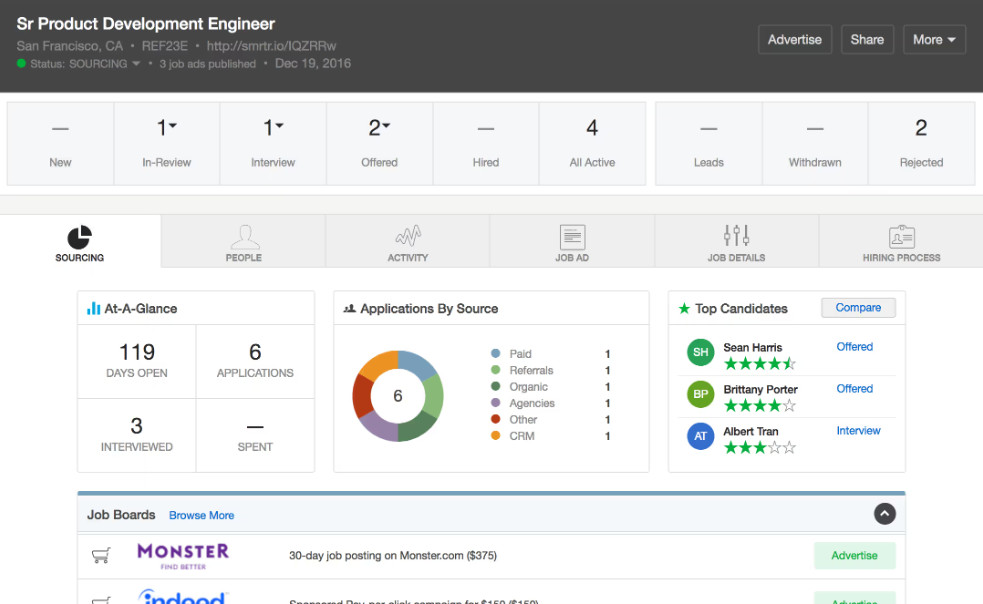
G2 rating: 4.3/5 based on 492 reviews.
Capterra rating: 4.2/5 based on 141 reviews.
SmartRecruiters' typical customers are primarily based in the United States (34.77%), with smaller shares in India (10.37%), the United Kingdom (6.25%), Canada (6.11%), and France (4.42%). Key industries include Computer Software (16%), Human Resources (12%), Staffing and Recruiting (10%), Hospital & Health Care (6%), and Education Management (6%).
According to G2, 56% of customers have 51-1000 employees, 12% have fewer than 50 employees, and 32% have more than 1000.
SmartRecruiters Pricing:
SmartRecruiters offers flexible, quote-based pricing typically ranging from $6 to $10 per employee per month (PEPM) or $39 to $100 per user per month. For companies with more than 50 employees, annual contracts often start around $10,000, with base pricing at approximately $850 per month. Organizations with larger employee counts may receive adjusted rates, while smaller companies may pay slightly higher per-user fees. Additional modules like CRM and onboarding may increase costs, which are based on company headcount and selected features.
SmartRecruiters Pros:
- User-Friendly Interface and Ease of Use (mentioned 12 times): Users appreciate the simple and intuitive interface, making it easy for both recruiters and hiring managers to navigate and use the platform.
- Integration with LinkedIn and Other Services (mentioned 4 times): The ability to integrate with LinkedIn and other services like Docusign for seamless candidate outreach and offer management is highly valued.
- Collaborative Candidate Management (mentioned 3 times): The platform facilitates collaborative candidate management, allowing team members to work in sync, rate candidates, and streamline the hiring process.
SmartRecruiters Cons:
- Difficulty in Navigation and Specific Actions (mentioned 2 times): Users find it tedious to switch between jobs and navigate to specific candidates within a job, especially if they are not in the expected stage.
- Integration and Customization Limitations (mentioned 2 times): Some users expressed a desire for more customization options and noted challenges in integrating SmartRecruiters with other ATS systems like Ceipal.
- Issues with Candidate Information Management (mentioned 2 times): There are difficulties in managing candidate information, such as merging candidates and keeping track of information provided by each candidate across different job applications.
- User Interface and Experience Concerns (mentioned 2 times): Although the user interface is generally liked, some users mentioned that it could be improved, and the software sometimes experiences technical glitches.
- Problems with Scheduling and Communication Features (mentioned 2 times): Users reported issues with the scheduling tool not being user-friendly and a lack of customization in initial messages to candidates, which could lead to candidates opting out of the process.
- Data Accuracy and Loss Issues (mentioned 2 times): Concerns were raised about the accuracy of contact information and a significant issue where user data, including job posts and candidate information, was deleted without notice.
- Limited Reporting and Analytical Tools (mentioned 1 time): Users find it challenging to create reports due to the vast number of fields available, indicating a need for more streamlined reporting capabilities.
- Job Posting and Candidate Dispositioning Limitations (mentioned 1 time): There is frustration with the job closing automatically upon hiring and the inability to bulk disposition candidates, requiring manual, time-consuming processes.
- Concerns Over Confidential Data Visibility (mentioned 1 time): Users are concerned about the open nature of the software, where confidential candidate data and internal communications are visible to anyone attached to the hiring team.
- General Dislikes and Suggestions for Improvement (mentioned 1 time): While some users expressed overall satisfaction with SmartRecruiters, they suggested improvements such as more automation, better graphic options in the email editor, and enhancements to the self-scheduling feature.
TalentReef
TalentReef, founded in 1997, is an applicant tracking system that raised $4 million and was acquired by Mitratech.
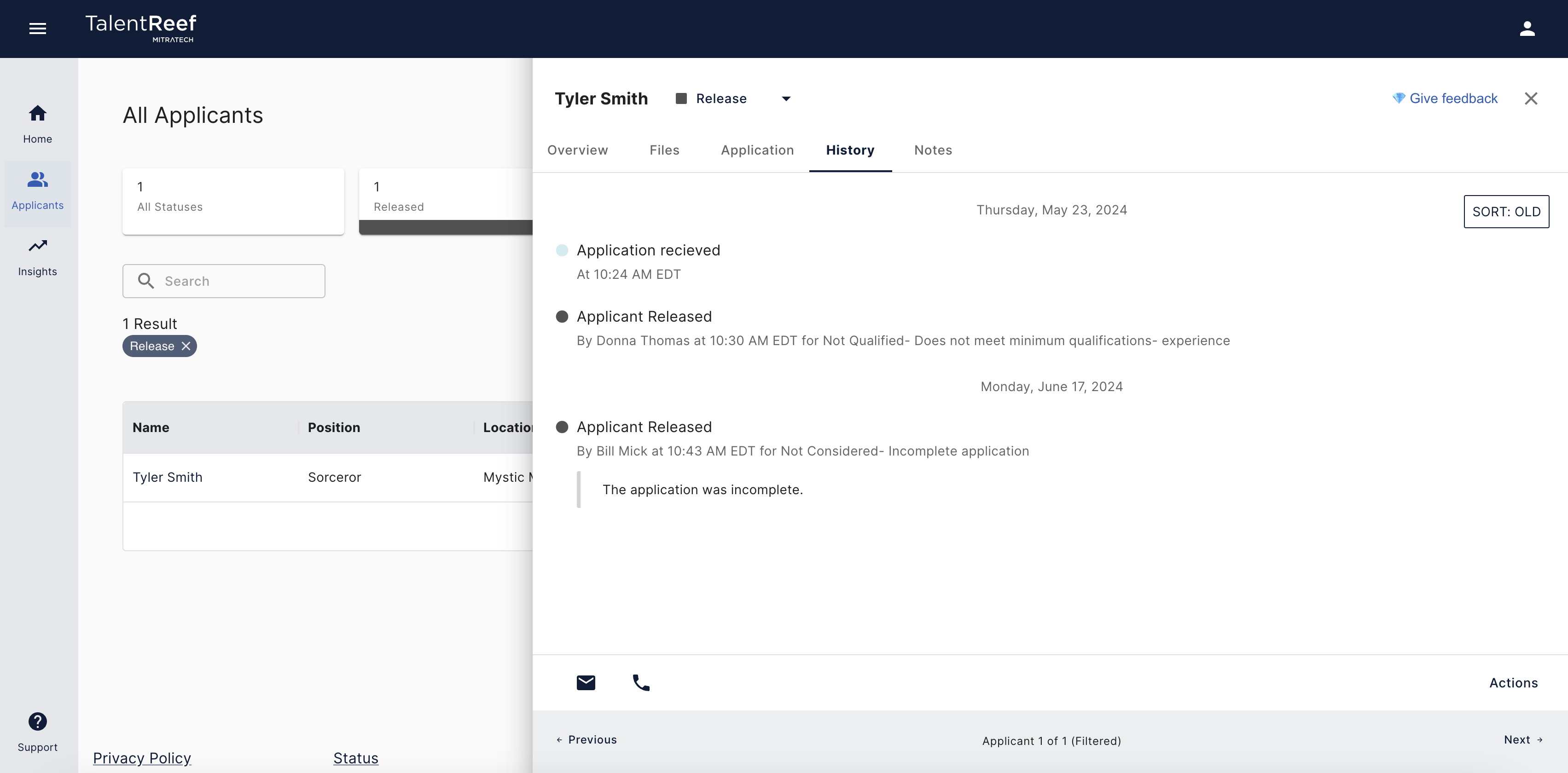
G2 rating: 3.8/5 based on 41 reviews.
Capterra rating: 3.5/5 based on 86 reviews.
TalentReef's typical customers are primarily based in the United States (99.24%), with small shares in Pakistan (0.55%) and Vietnam (0.21%). Key industries include Food & Beverages (48%), Retail (18%), Hospitality (15%), Restaurants (10%), and Hospital & Health Care (3%).
According to G2, 56.1% of customers have 51-1000 employees, 4.9% have fewer than 50 employees, and 39% have more than 1000. Capterra reviews show 20.9% of customers with 1,001-5,000 employees, and smaller shares across other size categories.
TalentReef Pricing:
TalentReef’s pricing starts at $55 per user per month, with options for both employee-based and location-based pricing structures. While specific plan details aren’t publicly listed, TalentReef offers flexible options, including a free plan, subscription, and free trial.
TalentReef Pros:
- User-Friendly Interface (mentioned 10 times): TalentReef is praised for its user-friendly interface for both hiring managers and candidates, making the application and hiring process straightforward and efficient.
- Efficient Onboarding and Electronic Documentation (mentioned 8 times): Users appreciate the electronic onboarding process and the ability to manage employee files electronically, which streamlines the hiring process and reduces paperwork.
- Customer Support and Account Management (mentioned 7 times): Having a responsive and helpful designated account manager and customer support team is highlighted as a significant advantage, aiding in resolving issues and improving system use.
TalentReef Cons:
- Customer Service and Support Issues (mentioned 14 times): Users report difficulties with customer service, including slow response times, unresolved tickets, and a lack of helpful assistance. Some users also mentioned the challenge of contacting support and the need to rely on account managers for resolutions.
- Integration and Technical Glitches (mentioned 8 times): There are ongoing issues with integrations, such as with Textus and Indeed, and users experience technical glitches, system shutdowns, and errors that affect the user experience and functionality.
- Limited Customization and Functionality (mentioned 7 times): Users desire more customization options, including the ability to add new positions or locations without submitting a ticket, and express frustration over the system's workflow limitations and lack of features like automated functions and more comprehensive onboarding tools.
- User Interface and Usability Challenges (mentioned 6 times): Some users find the platform clunky and not intuitive, with a steep learning curve for new users. There are also comments about the system being slow or freezing, especially when handling multiple applicants.
- Applicant and Onboarding Issues (mentioned 5 times): Difficulties with the onboarding process, including lost paperwork and complications with resetting passwords or resending onboarding emails, are mentioned. Users also note that the system does not effectively prevent duplicate applications.
- Limited Applicant Generation and Quality (mentioned 3 times): There are concerns about the platform not generating enough applicants or attracting low-quality candidates, which affects the hiring process's efficiency.
- Lack of Mobile Friendliness (mentioned 2 times): The platform's mobile usability is criticized, with suggestions for improvements to make it more accessible for applicants using mobile devices.
- Slow System Performance (mentioned 2 times): Users report sluggish performance and delays in accessing forms and applications, which can hinder the recruitment process.
- Lack of Comprehensive Training Resources (mentioned 1 time): A desire for more tutorials and training resources to better understand and utilize the platform's features effectively.
- Inadequate Reporting and Analytics (mentioned 1 time): Users would like to see improvements in reporting functionality to better track and analyze recruitment activities.
Taleo
Taleo, founded in 2012, is an applicant tracking system that acquired Jobpartners, Cytiva Software, Learn.com, Worldwide Compensation, Vurv Technology, WetFeet, JobFlash, Recruitforce.com, and White Amber, and was acquired by Oracle.
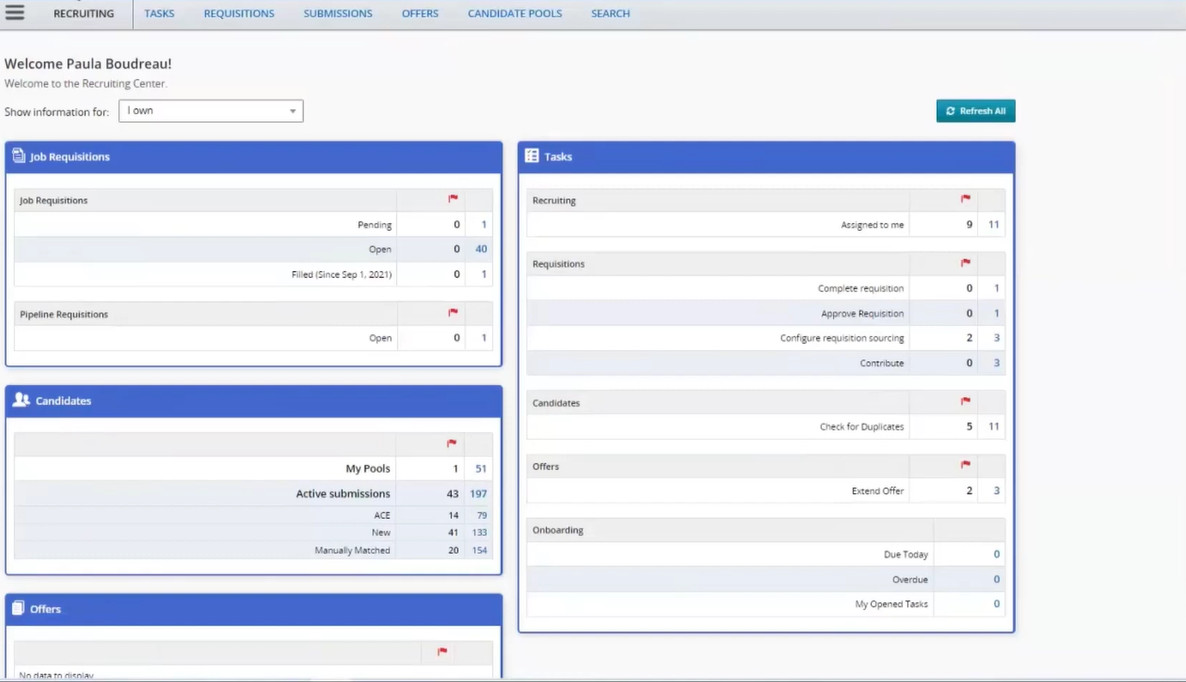
G2 rating: 3.4/5 based on 364 reviews.
Capterra rating: 3.8/5 based on 178 reviews.
Taleo's typical customers span industries like Computer Software (7%), Retail (6%), Hospital & Health Care (6%), Human Resources (5%), Higher Education (5%), and Medical Practice (4%).
According to G2, 60% of customers have more than 1000 employees, 28% have 51-1000 employees, and 12% have fewer than 50 employees. Capterra reviews show 21.6% of customers with more than 10,000 employees, and smaller shares across other size categories.
Taleo Pricing:
Oracle Taleo Cloud Service offers multiple subscription options, including:
Hosted Employee Subscription: Charges range from $0.50 to $5 per employee, depending on the minimum commitment and plan type.
Hosted Named User Subscription: Ranges from $0.50 to $1.50 per user, also based on commitment.
Optional Add-Ons: Includes services like test environments, VPN setup, and Oracle Database Vault, each with specific one-time or monthly fees.
Professional and Support Services: Custom pricing for remote system administration, data migration, integrations, and priority support, tailored for enterprise-level needs.
Taleo Pros:
- Ease of Use/User-Friendly Interface: Mentioned 29 times. Users appreciate the intuitive design and simplicity, making it accessible for users with varying levels of tech proficiency.
- Comprehensive Talent Management: Mentioned 18 times. Taleo is valued for its ability to manage the entire lifecycle of talent management, from recruitment to retirement, including performance management and learning development.
- Integration Capabilities: Mentioned 14 times. The ability to integrate with other systems, including ERP, EPM, and third-party software, is highly regarded for streamlining processes.
Taleo Cons:
- User Interface and Usability Issues: Mentioned 23 times. Users find the interface outdated, not intuitive, and sometimes clunky, highlighting a need for modernization and improved usability.
- Integration and Compatibility Challenges: Mentioned 12 times. Difficulties in integrating Taleo with other systems (e.g., ADP, Oracle modules) and issues with mobile integration were highlighted, indicating a need for better interoperability.
- Performance and Speed Concerns: Mentioned 11 times. Users experience slow performance, freezing, and browser compatibility issues, suggesting optimization is needed for a smoother experience.
- Complexity and Learning Curve: Mentioned 10 times. The system is described as complex and difficult to navigate, with a steep learning curve for new users, indicating a need for simplification and better training resources.
- Reporting and Analytics Limitations: Mentioned 9 times. Reports and dashboards are criticized for not being customizable or user-friendly, pointing to a need for more flexible reporting tools.
- Cost and Pricing Structure: Mentioned 8 times. Concerns about the cost, especially for large organizations and the pricing model based on headcount rather than actual users, suggest a need for more transparent and flexible pricing options.
- Customer Support and Technical Assistance: Mentioned 7 times. Users report challenges in obtaining timely and effective support, indicating a need for improved customer service.
- Limited Customization and Flexibility: Mentioned 6 times. The software's limited customization options for specific organizational needs and processes were noted, suggesting a need for more adaptable solutions.
- Data Management and Search Functionality: Mentioned 5 times. Difficulties with data migrations, ineffective search functions, and managing candidate information point to a need for enhanced data management capabilities.
- Outdated Technology and Features: Mentioned 4 times. References to the use of Flash and lack of modern features like drag-and-drop functionality indicate a need for technological updates to meet current standards.
the best candidates faster




